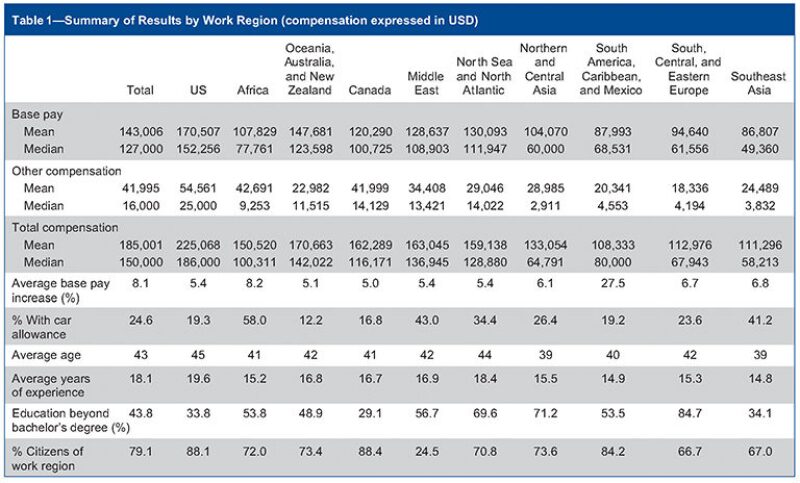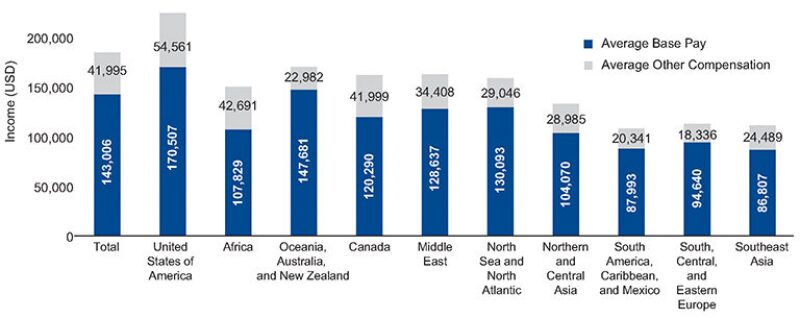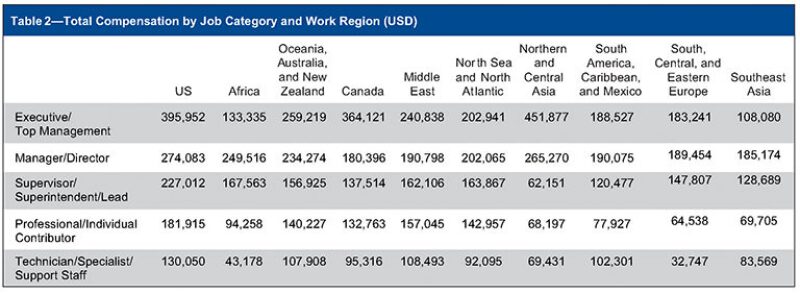Petroleum industry professionals reported an average calculated total compensation of USD 185,001 in 2016 (Table 1 and Fig. 1), less than reported in previous years, according to the latest annual SPE Salary Survey. Total compensation in previous years was USD 206,020 in 2015, USD 214,328 in 2014, and USD 203,557 in 2013.
Although the reported compensation in 2016 is less than in 2015, 35.9% of this year’s respondents indicated that their base pay increased from 2015 to 2016. However, this is a smaller figure than the previous 2 years’ percentage increases in base pay (58.5% saw an increase in 2015 and 82.2% saw an increase in 2014 from the previous year).


Calculated mean base pay reported in 2016 declined (USD 143,006) from previous years, while other compensation (including bonuses) has been declining since 2013. In 2016, members reported an average of USD 41,995 in other compensation. Again, this was a decrease from previous years (USD 52,931 in 2015 and USD 57,889 in 2014). The number of professionals receiving a car allowance also continued to decline, and was 24.6% in 2016.
Respondents to the survey had an average industry experience of 18 years. The number of professionals who reported an education level higher than a bachelor’s degree was 43.8% in 2016.
Job Categories and Total Compensation
The global mean for total compensation declined for every job category from 2015 to 2016 (Table 2). The most marked declines are from the top-tier professionals from the Africa; Oceania, Australia, and New Zealand; and South, Central, and Eastern Europe regions.

The professional and technician categories maintained the highest stability overall. For these two categories, nearly half of the regions were able to maintain or increase their level of compensation from 2015. Those who saw a decrease in salary experienced less of a decline in their compensation overall than the top tier of professionals.
Change in Base Pay by Region
Overall, 13.8% of respondents reported a decline in their base pay in 2016, and 35.9% of respondents reported an increase (Table 3), a clear change from 2015 survey results (6.6% of respondents saw a decline; 58.5% of respondents saw an increase).

Although the percentages stayed consistent for decrease in base pay across the regions from 2015 to 2016, there were a few considerable differences from 2015 for some of the regions for increase in base pay. The US, Canada, and Middle East regions had fewer respondents who saw an increase in their base pay in 2016, with the US down 28.4%, Canada down 27.6%, and the Middle East region down 25.8% from last year.
Increase in average base pay by region remained consistent from 2015 to 2016. While all other regions’ salary increases hovered around 5–8% (4–9% in 2015), the South America, Caribbean, and Mexico region had a 27.5% average base pay increase (25.2% in 2015).
Decrease in average base pay by region remained consistent from 2015 to 2016, with a few exceptions. Oceania, Australia, and New Zealand dropped from −21.3% in 2015 to −31.9% in 2016. The North Sea and North Atlantic region (−18.7% in 2015) saw the largest percentage decline in average base pay in 2016 to −30.3%.
How To Learn More
This report represents a sample of current compensation in the industry. A detailed summary report containing charts and descriptie statistics of trends and more information on the jobs, geographies, and employer types are aailable through the SPE Bookstore at www.spe.org/store.

